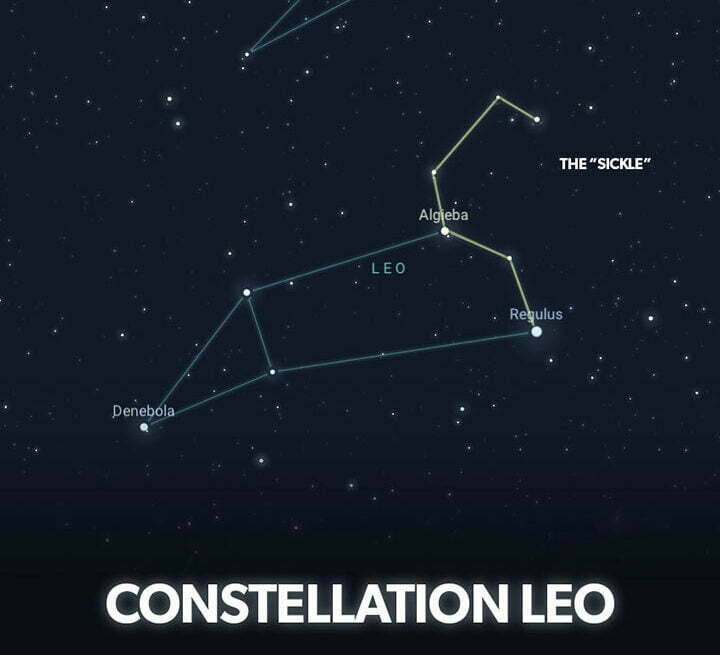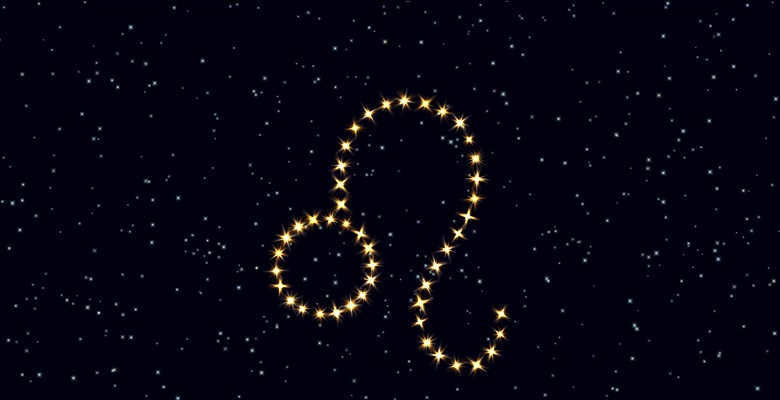Throughout the globe, both children and adults enjoy gazing up at the stars, recognizing the familiar ones and uncovering new and unknown constellations. However, beyond mere enjoyment, these very stars and constellations served as a means to track the changing of seasons.
Today, these constellations serve as useful tools for both professional astronomers and amateur stargazers. We are aware of the existence of the zodiac signs: the traditional twelve representatives and a more recent addition. However, let’s delve deeper into the zodiacal constellations: their origins, locations, and appearance.
Historical Background
The celestial bodies traverse the expanse of the heavens in accordance with their customary pattern, much like the Sun. At different points in the year, various constellations become visible at sundown. The ascendant constellations undergo a rotational movement dictated by the Earth’s motion in the cosmos. Consequently, they remain useful for discerning seasonal shifts in areas where moderate climates fail to exhibit distinct demarcations between winter and spring.
The majority of the familiar constellations derived their designations from the mythologies of ancient Greece and Rome. However, individuals were already denoting them on maps prior to the official naming bestowed upon them by these empires.
The constellation system used by the Greeks was passed down from the Babylonians, who likely borrowed from Sumerian traditions dating back 3000 years. However, even earlier references exist. It is believed that the markings found on the walls of the Lascaux Cave in southern France, created over 17,000 years ago, may depict the Pleiades and Hyades star clusters, making it the earliest known star map.
In 1929, the International Astronomical Union (IAU) officially established 88 constellations on a night sky map. These defined boundaries allow astronomers to easily differentiate various parts of the sky, providing a convenient tool for their work.
Constellations, in reality, are celestial areas shaped like rectangles and filled with stars. These star groupings can be assigned names. For instance, the collection of stars surrounding the asterism called the Big Dipper is known as the constellation of the Big Dipper.
Nevertheless, many individuals hold the belief that several star groups are not officially recognized as constellations. The Big Dipper, which is situated within the constellation of the Big Dipper, is not acknowledged as a constellation but rather as an asterism. In other words, it is an officially undefined group of stars that is widely known among amateur astronomers.
The Sun, Moon, and planets travel along a specific celestial path known as the ecliptic. The zodiacal constellations, which consist of 13 constellations, are the ones through which these celestial bodies pass. Traditionally, it was believed that there were only 12 zodiac constellations. However, recent research has expanded the list to include 13 zodiac signs.
Compilation of astrological constellations
Astrologers utilize a set of 12 constellations as zodiac signs, excluding the Serpentine constellation to form the widely recognized predictions. Unlike astronomy, astrology is not regarded as a scientific field. The zodiac signs and constellations bear only a vague connection to one another.
For instance, the sign of Pisces corresponds to the rising of the Aquarius constellation. Interestingly, if you were born under a specific zodiac sign, the corresponding constellation is not visible during the nighttime. Instead, the Sun passes through it during this time of year, designating this day as the unobservable constellation’s day.
What is the distance between the zodiacal constellations?
While constellations create patterns in the night sky, the stars themselves are not arranged in specific shapes in outer space. The distance between our planet and the individual stars within a constellation can vary, often spanning tens of light years, resulting in a scattered distribution of stars throughout the galaxy.
The images we see in the night sky are formed due to our limited perception of only two dimensions, lacking the depth that exists in reality.
However, the zodiacal constellations still serve as landmarks and ignite our imagination. They assist observers in locating planets, comets, and other celestial phenomena, acting as a useful reference point in the night sky.
Explore our online models to see all 13 zodiacal constellations in the sky, along with the brightest stars.
Seasonal Constellations
The representation of this astrological sign is depicted by a circular shape, representing the head, along with a curved line connected to it, which suggests the body and tail of the depicted animal. Occasionally, this “curl” is interpreted as resembling a lion’s mane.
With this interpretation, the circle in the symbol represents the Sun, which is the patron of individuals born under this sign. The Sun’s influence bestows upon them a strong character and a heightened creative ability.
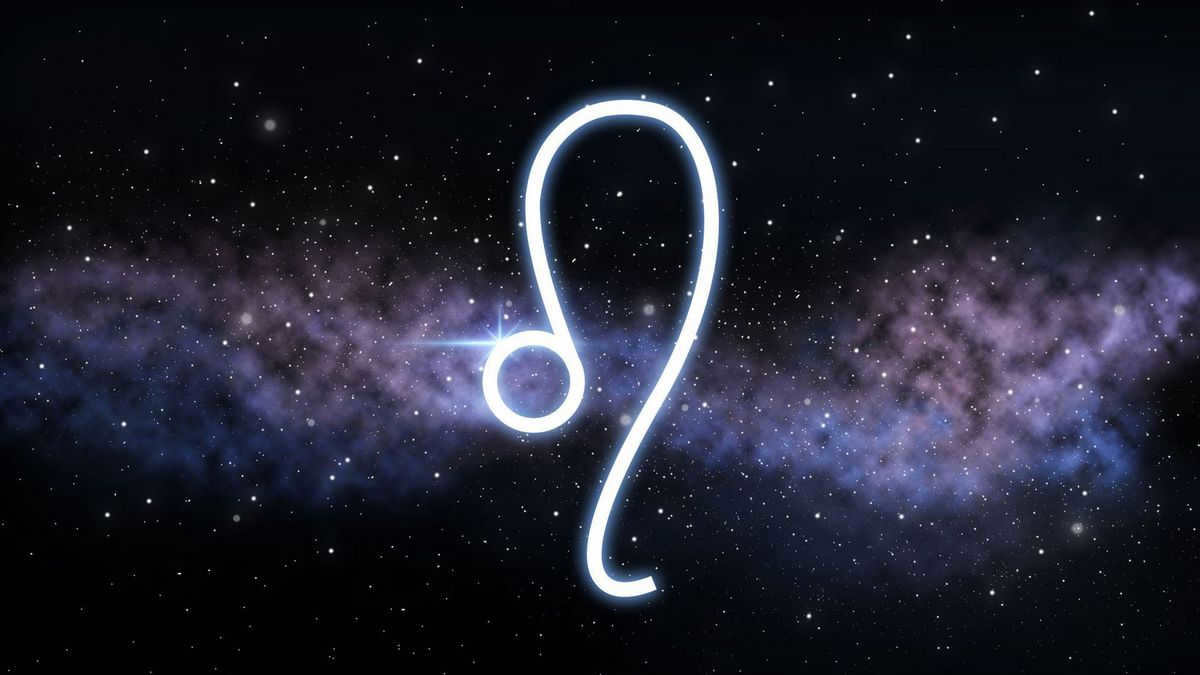

According to an alternative theory, the Leo zodiac sign can be compared to sperm, symbolizing the “masculine” nature of individuals born under this sign.
Is there a difference between the sign of Leo and the constellation of Leo?
According to astronomical data, the Sun moves through the constellation of Leo from August 10 to September 15, which lasts for 37 days. However, this period does not align with the time when Leo is said to reign in astrology.
The duration of the Sun’s passage through Leo, as well as other constellations, is determined by physical laws and has no relation to the calendar. The reason why the “astrological” Leo begins almost a month earlier than the Sun’s passage through the constellation is due to the phenomenon of precession.
The Earth’s rotation around its axis is influenced by various factors, including the gravitational pull of the Moon and the Sun, as well as the tilt of its axis. As a result, its movement is not strictly along the axis that runs from pole to pole, as depicted on a globe, but rather deviates from it.
As a consequence, the positions of the constellations above us have shifted over the centuries. This means that the current astronomical reality does not align with the astrological concept that emerged over two thousand years ago. In another 23 thousand years, the Earth will complete a full rotation with its tilt, resembling the movement of a wolf, and the Sun will traverse the constellations in accordance with the zodiacal calendar, thus completing a full circle.
Famous individuals born under the astrological sign of Leo
Locating the constellation Leo
The Leo constellation can be found situated between Cancer and Virgo. It is home to numerous stars and galaxies, with several notable features.
One of the primary stars in this constellation is known as Regulus. Its name stems from the Latin word for “king,” while the Arabs referred to it as the lion’s heart.
Regulus is a relatively young celestial object and ranks among the top 20 brightest stars. In reality, it is composed of multiple luminous components, with the brightest being three and a half times more massive than our Sun. It rotates rapidly, completing one revolution on its axis in just sixteen hours. Additionally, Regulus has two fainter companions that orbit around a common center of gravity, resulting in a revolution around the main star that takes 130,000 years.
Algieba, the other most prominent feature of Leo, derives its name from the Arabic word for “forehead,” although this name is somewhat misleading. In reality, this star is located closer to the lower part of the starry lion’s imaginary mane. Its Latin designation, Juba, meaning “mane,” reflects this positioning. Algieba is comprised of a pair of massive stars. One of these giants is ten times larger than the Sun, while the other is twenty-three times larger. These stars have already reached a couple of billion years in age and are considered quite old. They have undergone nuclear processes that have depleted their hydrogen reserves, causing them to expand in size.
Delta Leo is another part of the constellation. It is known as Zosma in Greek, which translates to “loins”. The Arabs referred to it as the back of the lion. Zosma is larger in size compared to the Sun and will have a shorter lifespan than our planet’s star. Over the next 600 million years, it will undergo stellar evolution, transforming into an orange or red giant before eventually becoming a white dwarf, signifying the end of its existence.
Leo is most visible in Russia during the months of February and March. By mentally connecting the brightest stars in the constellation, one can observe a shape resembling a trapezoid, which represents the lion’s “body”. The star located at the lower right corner of this trapezoid is known as Regulus.
Above, there are four additional bright points that, along with Regulus, create a curved pattern resembling a question mark facing the opposite direction. This chain of stars forms the front part of the torso and head of the celestial king of beasts.
The legend of Leo constellation
In Greek mythology, the Lion was the first monstrous creature that Hercules defeated during his 12 labors.
A gigantic lion, the offspring of Typhon and Echidna, had descended from the moon and posed a threat to the city of Nemea. Due to its impenetrable hide, no one could kill it.
Initially, Heracles attempted to shoot arrows at the Lion, but they simply bounced back. The hero then struck the beast on the head with a club and proceeded to strangle it. He skinned the lion, utilizing the animal’s own claws, and began wearing its hide as a protective cloak.
Desiring to immortalize the achievement of his son, Zeus, the god, positioned the Lion in the sky as a constellation.
In general, constellations are considered as the dwelling places for the most prominent and influential celestial bodies, namely the luminaries. The Lion, which symbolizes masculinity, represents the Sun.
Leo, as a zodiac sign, is generally characterized as hot and stifling. However, the leading part of Leo is particularly stifling and harmful, the middle part is characterized by moderation, and the last lobe is damp and destructive. The northern regions of this sign are changeable and scorching, while the southern regions are damp.
Excerpt from Claudius Ptolemy’s Tetrabiblos
Text:
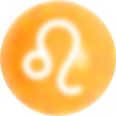
Figure 1
The representation of the Leo zodiac sign: ♌
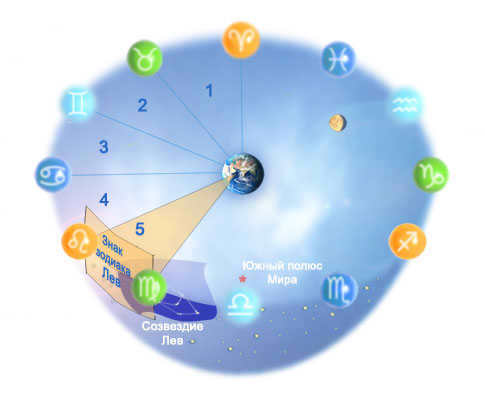
Figure 2 displays the Leo zodiac sign, the Leo constellation, and their relative positions in a spherical projection. This ancient representation of the heavens consisted of multiple spheres nested within each other.
The signs of the zodiac have a long history of being used to mark the celestial sphere, initially near the ecliptic region and later encompassing the entire celestial sphere.
These signs were primarily used to record the coordinates of celestial luminaries, such as the ecliptic coordinates of Alpha Leo, the brightest star in the Leo constellation, known as Regulus: (149°49’42”,+0°28’05”) or in decimal degree fractions: (149.83°; 0.47°). The ancient Greeks would have represented this as: ♌29 5/6°; N 0 1/2°, although during Ptolemy’s time, the coordinates of Regulus were different – it was practically the beginning of Leo. According to the Almagest, the coordinates were: ♌ 2 1/2°; N 0 1/6°.
Over time, the marked areas gradually shift along the ecliptic plane due to the Earth’s axis precession. In our current time, the star Regulus marks the final border of the Leo sign, indicating that over the course of two millennia, the signs of the zodiac have shifted by almost 30°. The current appearance of the sky corresponding to the Leo sign is as follows:
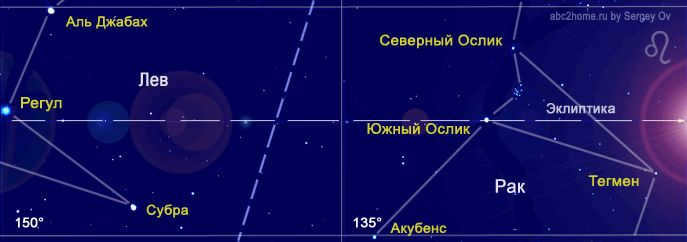
Figure 3: The Leo zodiac sign ♌ represents a specific section of the starry sky that corresponds to the current sign of Leo in 2016. This area includes the majority of stars from the Cancer constellation and the “front paw” of the Leo constellation.
According to the philosophical ideas of Claudius Ptolemy, the Leo zodiac sign possesses exceptional properties:
– The Leo zodiac sign is associated with masculinity and is considered the dwelling place of the Sun, which objectively influences the life of all things on Earth.
– The symbol of Leo represents maturity and the perfection of the Fire element. According to ancient Greek philosophers, individuals born under this sign also possess the qualities of warmth and dryness associated with this element. The Sun’s presence in Leo at the time of birth is said to influence a person’s temperament, specifically the choleric type.
– Ancient Greek philosophers ascribed various characteristics and properties to each zodiac sign. In the case of Leo, its position relative to the equatorial plane during the Sun’s transit through it is considered northern. Additionally, Leo is associated with the summer season. This sign is believed to harmonize with the noble metal gold and the precious stone amber.
Many modern astrological schools are based on these elements of the ancient worldview, which include the position of earthly and heavenly time, the perfection of celestial spheres, and the imperfection of all things earthly. This also supports the belief that “everything is predestined in heaven.”
Historically, the initial forecasts made by astrologers coincided with the establishment of the first agricultural societies. These prognostications focused primarily on predicting the outcome of the harvest. Agricultural communities relied heavily on being able to anticipate weather patterns and climatic events in order to ensure successful crop growth and overall prosperity. Given the cyclical nature of weather phenomena (such as floods and droughts), people began to observe and track the movements of planets, the Moon, and the Sun, drawing connections between these celestial bodies and the corresponding weather conditions. By studying the positions of the planets, which were described using zodiac signs at the time, individuals were able to not only recognize the cyclical patterns of weather events but also make predictions based on their celestial alignments.
The prediction for the harvest puts great emphasis on the Moon, which is considered the “planet of fertility”. It takes into account the Moon’s phases and how it interacts with the signs of the zodiac. Hence, this article focuses on the impact of the Moon in the sign of Leo on plants. The sign of Leo, the Moon, and plants are all connected in this discussion. For those who are not particularly interested in the intricacies of the Moon’s influence on plant growth, here’s the main point: the fire sign Leo is not very favorable for abundant and succulent harvests, but it does support the growth of plants that strive towards sunlight.
The Zodiac Sign of Leo, The Sun, and The Planets
According to Claudius Ptolemy’s explanations, ancient Greeks believed that when passing through the zodiacal sector of Leo:
☉ The Sun holds the greatest power of influence over earthly life (from 3 to 2 2/3 conventional points, with 1 point representing the power of influence at the moment of exaltation);
☽ The Moon in Leo’s sector is near the peak of its strength, but its powers are already diminishing (from 2 2/3 to 2 points);
♀ Venus in Leo still possesses power, but its influence is noticeably weakening (from 1 1/3 to 1 point);
♃ Jupiter is just beginning to gather strength – its growth is rapid (from 1 to 1 1/3 points);
☿ Mercury – is not currently in effect, but its influence is growing and approaching manifestation (from 2 /3 to 1 point);
♂ Mars – is currently powerless and continuing to weaken (2 /3 → 1 /3);
♄ Saturn – is at its weakest point (0 points).
What is the reason behind the unusual proportions of the Great Sphinx?
The image depicted reveals the answer without any verbal explanation: The outline of the modern constellation Leo, along with an additional star, aligns perfectly with the contour of the Great Sphinx.
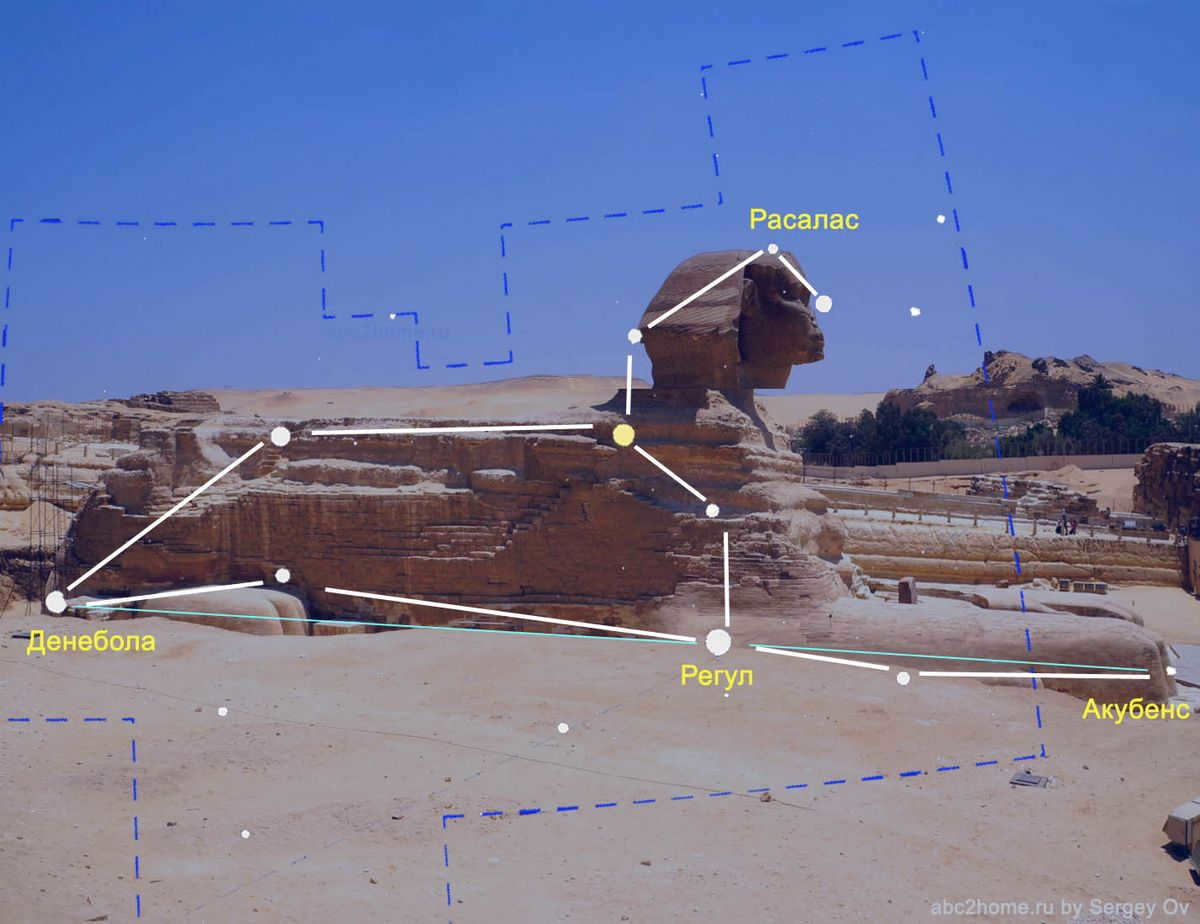
Constellation Leo and the Great Sphinx by Sergey Ov
Collage. Constellation Leo and the Great Sphinx Note: The wise men of Ancient Egypt were not aware of the modern “learned men and wives of astronomy” method of dividing the sky into constellations, and depicted the star pattern in their own unique way. As a result, the paws of the Sphinx are positioned on the star Akubens from the contemporary Cancer constellation (Alpha Cancer, lat. α Cnc).
The zodiac sign Leo and its influence on individuals. “A quintessential Leo.”
Today, it is widely accepted that if an individual is born while the Sun is positioned in the Leo zodiac sign, their astrological sign is Leo. Additionally, the designation “Lion” or “Lioness” serves as another defining characteristic, implying that they are expected to embody the traits of a “typical lion”. However, it is important to note that the notion of a “typical Lion” is purely fictional and only exists within the realm of entertaining literature, often categorized as “scientific-provocative”. These works often playfully exaggerate the ego of “Lions” and “Lionesses”, providing lengthy lists of remarkable character traits under headings such as “Man Lion” and “Woman Lion”. Even ancient Greek philosophers, as well as their later followers, primarily believed that one’s zodiac sign solely determines their dominant temperament and mental fortitude (Ptolemy referred to it as “resistance to fate”), while their character develops over the course of their life’s journey.
The predominant temperament type associated with Leo is choleric, and the mental fortitude or “resistance to fate” is balanced by the expression of this temperament.
The topic of compatibility among “Lions” in relationships with both fellow Leos and individuals born under other zodiac signs is explored in a dedicated article titled “Compatibility by Zodiac Sign and Temperament: Types of Temperament According to Hippocrates”, which is of great interest to many individuals.
* The Leo Constellation
“The two stars in Leo’s head have a similar influence to Saturn and, to a lesser extent, Mars; the three stars in the throat region have a similar influence to Saturn and, to a lesser extent, Mercury; the bright star in the heart region, known as Regulus, has a similar influence to Mars and Jupiter; the stars in the back and the bright star on the tail have a similar influence to Saturn and Venus; the stars in the hip region have a similar influence to Venus and, to a lesser extent, Mercury.” (Figure 8) Claudius Ptolemy – On the Influence of the Stars – “A Mathematical Treatise in Four Parts” Currently, the Sun passes through the Leo constellation (♌ Leo -Lat.) from August 11 to September 17.
Due to the Earth’s axis precession, constellations shift relative to the vernal equinox point, and the Sun’s visible movement through the zodiacal constellations occurs with increasing delay. After completing a full zodiacal circle, constellations return to their initial positions every 25776 years.
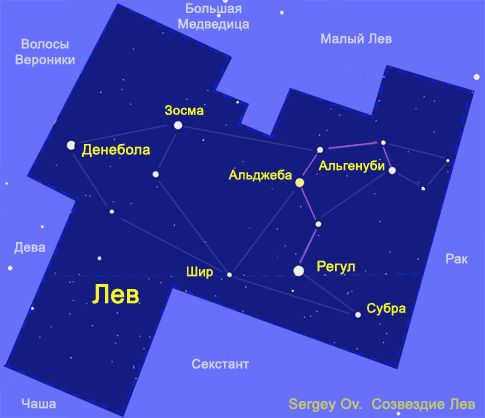
The constellation Leo, Leo’s stars, is depicted in Figure 4. The seven brightest stars of Leo are shown. The lilac line represents the asterism known as the “Sickle” and is the symbol of Leo.
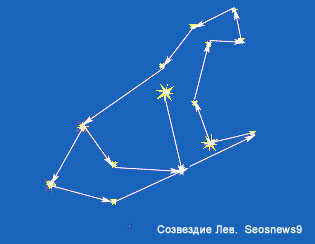
Figure 5: This diagram depicts the constellation Leo. It is our unique representation of a star chart, featuring an outline image of Leo.
The constellation Leo is the most prominent zodiacal constellation in the northern sky. There are up to five stars brighter than third magnitude in the constellation – these are (Fig.4) Alpha Leo (α Leo) Regulusdouble γ Leo Aljebaβ Leo Denebola and Zosma (δ Leo) with ε Leo. Algenubi (Fig.4). As shown in the figure, the names of seven stars are given – the stars Subra (ο Leo) and Shir(ρ Leo) are not the brightest, but they are important for the construction of the constellation scheme (Fig.5) and have been added.
It is interesting to note that the brightest star Regulus (α Leo) is almost on the ecliptic line (with a deviation of only 27′ minutes), while the star ρ Leo Shire deviates from the ecliptic by 8′ minutes.
We have inherited the modern boundaries of the Leo constellation from the ancient Greeks. However, throughout history, people have always recognized a distinctive sickle pattern within this constellation, now known as the “Sickle asterism”. This asterism deserves a separate image (Fig.5). All the stars included in the Sickle asterism, even the less bright ones, have their own names given by different peoples. The chain of stars in the sickle includes: Regulus, Al Jabah (η Leo), Aljeba, Aldhafera (ζ Leo), Rasalas (μ Leo, Ras Elased Borealis), and Algenubi (Ras Elased Australis). 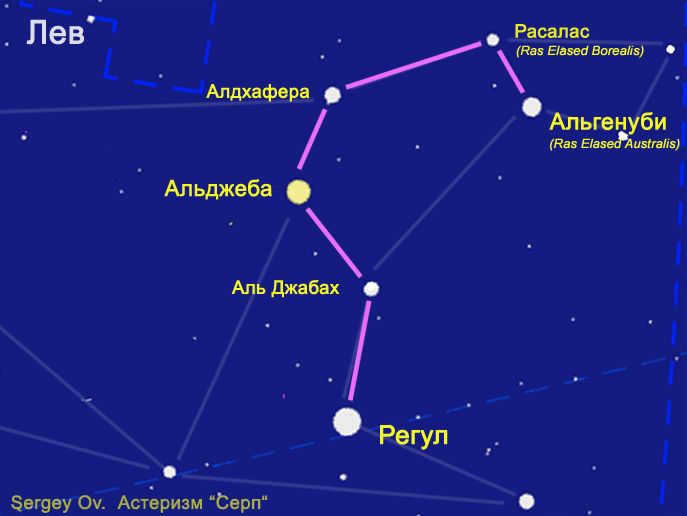 Fig.6 Asterism Sickle in the Leo constellation. List of stars in the Sickle asterism. In the figurative drawings of the starry sky by the ancient Egyptians, almost all their celestial beings were depicted with wings. Additionally, they did not depict creatures resembling earthly beings. If a celestial being had a human body, its head would be that of a noble animal, or vice versa, as in the case of the sphinx. It is unknown what images the ancient Egyptians imagined in the starry sky when creating the Great Sphinx, but it is possible that its image was based on the stars of the modern Leo constellation, which could be confirmed by the discovery of wooden wings attached to it.
Fig.6 Asterism Sickle in the Leo constellation. List of stars in the Sickle asterism. In the figurative drawings of the starry sky by the ancient Egyptians, almost all their celestial beings were depicted with wings. Additionally, they did not depict creatures resembling earthly beings. If a celestial being had a human body, its head would be that of a noble animal, or vice versa, as in the case of the sphinx. It is unknown what images the ancient Egyptians imagined in the starry sky when creating the Great Sphinx, but it is possible that its image was based on the stars of the modern Leo constellation, which could be confirmed by the discovery of wooden wings attached to it. 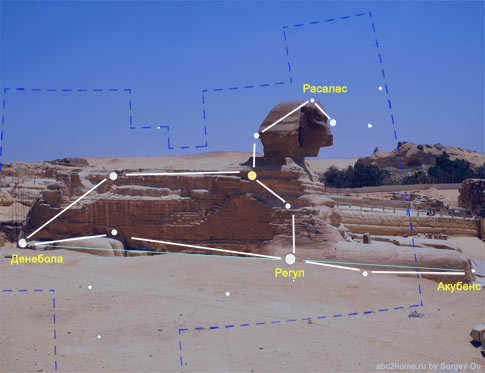 Fig.7 The Leo constellation and the Great Sphinx. To learn more about the peculiarities in the proportions of the Great Sphinx, click on the picture. Along with the boundaries of the Leo constellation, we have also inherited the myth of its origin from the ancient Greeks. According to Greek mythology, the first feat of Hercules is immortalized in the Leo constellation. The lion is brought to the heavens as a result of Hercules’ victory over the monster in the form of a lion that devastated the province of Nemea (hence the phrase “Nemean Lion”). In his star catalog, Claudius Ptolemy tries to follow this tradition and includes the stars that create the image of a lion in the representations of his time in the Leo constellation. Later, Jan Hevelius, in his atlas “Uranographia”, tries to closely follow Ptolemy’s descriptions. Unfortunately, the original atlas is created in the projection of a “divine view”, as if looking at the celestial sphere from the outside. To make the picture correspond to the “earthly” view of the Leo constellation and to highlight the stars, the collage presented here was created:
Fig.7 The Leo constellation and the Great Sphinx. To learn more about the peculiarities in the proportions of the Great Sphinx, click on the picture. Along with the boundaries of the Leo constellation, we have also inherited the myth of its origin from the ancient Greeks. According to Greek mythology, the first feat of Hercules is immortalized in the Leo constellation. The lion is brought to the heavens as a result of Hercules’ victory over the monster in the form of a lion that devastated the province of Nemea (hence the phrase “Nemean Lion”). In his star catalog, Claudius Ptolemy tries to follow this tradition and includes the stars that create the image of a lion in the representations of his time in the Leo constellation. Later, Jan Hevelius, in his atlas “Uranographia”, tries to closely follow Ptolemy’s descriptions. Unfortunately, the original atlas is created in the projection of a “divine view”, as if looking at the celestial sphere from the outside. To make the picture correspond to the “earthly” view of the Leo constellation and to highlight the stars, the collage presented here was created: 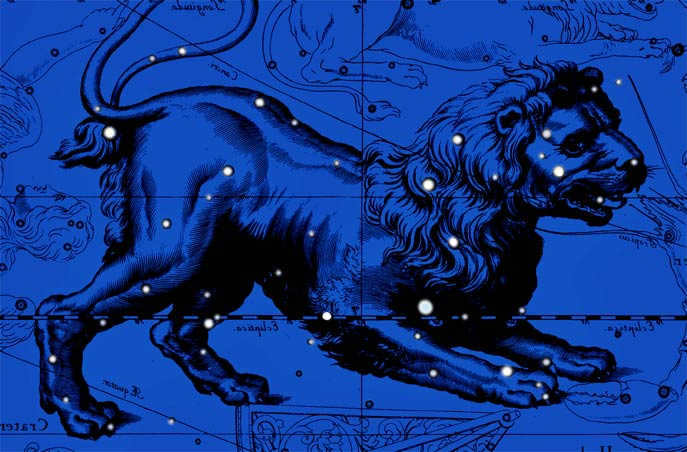 Fig. 8 The Leo constellation – collage based on the picture in Jan Hevelius’ atlas (only the stars entered by Hevelius himself in the atlas are illuminated).
Fig. 8 The Leo constellation – collage based on the picture in Jan Hevelius’ atlas (only the stars entered by Hevelius himself in the atlas are illuminated).
ARCHIVE
NAVIGATION AND ADVERTISING
“The two stars in Leo’s head have a similar effect to Saturn and, to a lesser extent, Mars; the three stars in the throat area are like Saturn and, to a lesser extent, Mercury; the bright star in the heart area, known as Regulus, is similar to Mars and Jupiter; the stars in the back and the bright star on the tail have a similar effect to Saturn and Venus; the stars in the thigh area have a similar effect to Venus and, to a lesser extent, Mercury.” (Figure 5)
Claudius Ptolemy – On the Influence of the Stars – “A Mathematical Treatise in Four Parts”
“The constellation Leo is the first topic in a series of publications on constellations, initiated in response to a request from a school astronomy teacher (Forum).
– Astronomy is currently not a mandatory subject and is taught as an elective.”

Figure 1: Diagram of the constellation Leo (♌)
The Leo constellation (♌, Leo) is the third largest constellation in the zodiac group. 1 Furthermore, Leo ranks 12th in terms of angular area among all constellations in the celestial sphere (firmament) and 5th among constellations in the Northern Hemisphere. This constellation is intersected by the celestial equator and the ecliptic, with most of it located above (north of) these lines. Finding the Leo constellation is quite straightforward, as the Big Dipper is directly above it, Virgo is to the right, Cancer is to the left, and the Sextant and Bowl are below.
At present, the Sun passes through Leo from August 11 to September 17, and the best conditions for observation are between February 9 and March 18 (Leo culminates at midnight).
Stars and outline diagram of the Leo constellation
The Leo constellation is widely recognized as one of the most prominent constellations in the northern sky. Within this constellation, there are up to five stars that shine brighter than the third magnitude. These stars include Alpha Leo (α Leo) or Regulus, double gamma Leo (γ Leo) or Aljeba, beta Leo (β Leo) or Denebola, and delta Leo or Zosma (δ Leo) with epsilon Leo. Additionally, we have Algenubi (Figure 2) in this constellation.

Leo is a constellation that is known for its stars. Sergey Ov has written about the stars in the constellation Leo.
Figure 2: Leo Constellation. Seven brightest stars. The lilac line represents the asterism “Sickle” and the symbol of Leo.
As shown in the figure, the names of seven stars are indicated – not the brightest ones, but important for constructing the constellation scheme (Figure 3) – Subra (ο Leo) and Shir (ρ Leo) stars have been added.
It is worth noting that the brightest star, Regulus (α Leo), is located almost on the ecliptic line (with only a 27′ minute deviation), and the star ρ Leo Shire deviates from the ecliptic by 8′ minutes.
To create our own version of the schematic contour drawing of the Leo constellation, we use almost the same stars as in the traditional schemes, but our contour clearly visualizes a lion lying down:
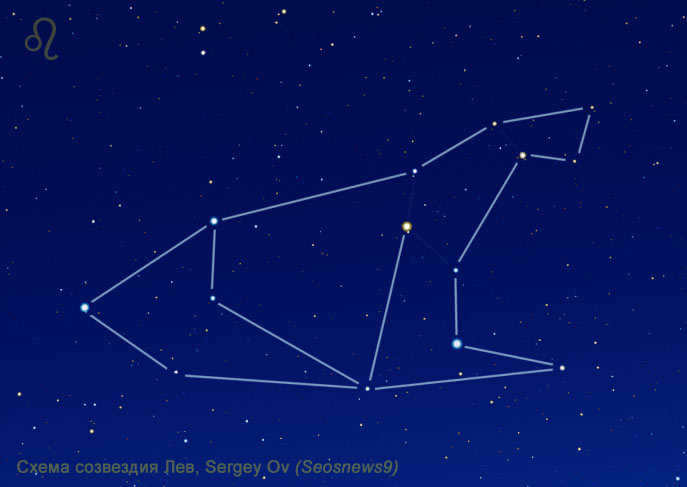
Figure 3: Diagram of the Leo constellation. Our own version of the star diagram (outline image) of the lion.
Contour diagram by stars:
Aljeba γ of Leo (γ Leo) – Shir ρ of Leo (ρ Leo) – Subra ο of Leo (ο Leo) – Regulus α of Leo (α Leo) – Al Jabah η of Leo (η Leo) – Algenubi ε of Leo (ε Leo) – Alterf λ of Leo (λ Leo) – κ of Leo (κ Leo) – Rasalas μ Leo (μ Leo) – Aldhafera ζ Leo (ζ Leo) – Zosma δ Leo (δ Leo) – Denebola β Leo (β Leo) – Tse Tseang ι Leo (ι Leo) – Shir ρ Leo (ρ Leo) – Shertan θ Leo (θ Leo) – Zosma δ Leo (δ Leo).
If desired, Leo’s tail can be “finished” (visible when cursor is moved):
Denebola β Leo (β Leo) – σ Leo (σ Leo) – Shir ρ Leo (ρ Leo).
The modern boundaries of the Leo constellation have been inherited from the ancient Greeks. However, throughout history, people have always recognized a distinctive sickle pattern within this constellation, now known as the “Sickle asterism.” This asterism deserves a separate image (Figure 5). All the stars included in the Sickle asterism, even the less bright ones, have their own names given by different peoples. The chain of stars in the sickle starts from the handle and ends with the tip: Regulus, Al Jabah (η Leo), Aljeba, Aldhafera (ζ Leo), Rasalas (μ Leo, Ras Elased Borealis), and Algenubi (Ras Elased Australis). You can see a list of more than 120 Leo stars by accessing the list of notable and visible stars in the Leo constellation.

Figure 4: Sickle asterism in the Leo constellation. List of stars in the Sickle asterism.
Once the contours and the brightest stars of the constellation have been studied for automatic recognition, you can start searching for the Leo constellation directly in the starry sky.
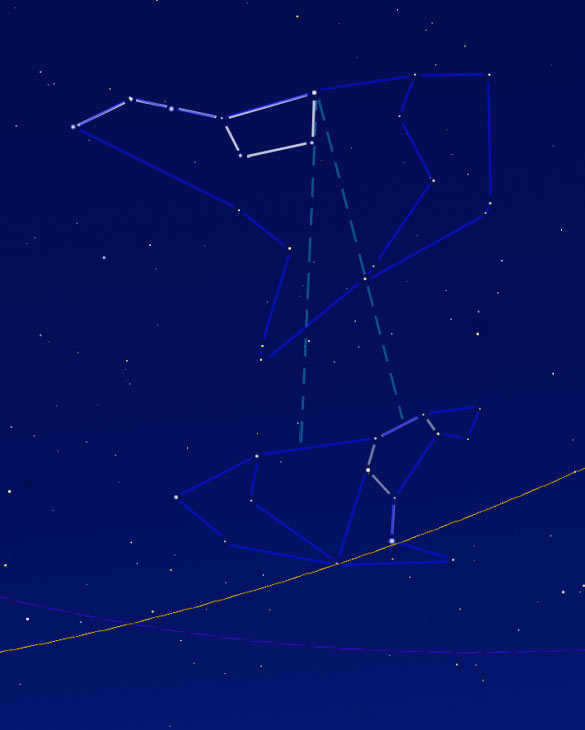
If you’re searching for the Leo constellation for the first time, there are two ways to find it: you can either wait for the Moon to come close to it and use the Moon as a guide (hover your cursor over the Moon), or you can locate it from a familiar constellation that doesn’t set. In this case, that would be the Big Dipper (Fig. 5).
Take a look at the Big Dipper and imagine water pouring out from its far side.
This water will pour directly onto the back of the lion! Fig.5. Finding the Leo constellation is very simple! It is positioned below the Big Dipper. The Leo and Big Dipper constellations align precisely in the south around midnight at the end of winter, as shown in Fig. 5. I believe the illustration speaks for itself (if you have any further questions, feel free to ask in the forum)
The Historical Background and Mythology of the Leo Constellation

What is the reason for the unusual proportions of the Great Sphinx?
Looking at the image provided, it becomes evident that the answer can be deduced without any explanation: The outline of the contemporary constellation Leo, along with an additional star, aligns perfectly with the outline of the Great Sphinx.

The constellation of Leo and the Great Sphinx
Artwork. The constellation of Leo and the Great Sphinx. Please note that the ancient sages of Egypt did not have knowledge of how the sky is divided into constellations as modern astronomers do. They represented the pattern of stars in their own unique way. In their depiction, the paws of the Sphinx end on the star Akubens, which is part of the modern constellation of Cancer (Alpha Cancer, lat. α Cnc).

A Compilation of Well-Known and Prominent Stars in the Leo Constellation
| Star | Bayer Designation | Right Ascension 2 | Declination 2 | Magnitude | Distance, Light-years | Spectral Class | Star Name and Notes |
| Alpha Leo | α Leo | 10 h 08 m 22.46 c | +11° 58′ 01.9″ | 1.36 | 77 | B7V | Regulus (Regulus Cor Leo, Qalb, Kabelaced, Qalb al-Asad) |
| Gamma 1 Leo | γ 1 Leo | 10 h 19 m 58.16 c | +19° 50′ 30.7″ | 2.01 | 126 | K0III | Algieba (Algieba, Al Gieba, Algeiba) |
| Beta Leo | β Leo | 11 h 49 m 03.88 c | +14° 34′ 20.4″ | 2.14 | 36 | A3Vvar | Denebola (Deneb Alased, Deneb Aleet) |
| Delta Leo | δ Leo | 11 h 14 m 06.41 c | +20° 31′ 26.5″ | 2.56 | 58 | A4V | Zosma (Zosma, Zozma, Zozca, Zosca, Zubra, Duhr, Dhur) |
| Epsilon Leo | ε Leo | 09 h 45 m 51.10 c | +23° 46′ 27.4″ | 2.97 | 251 | G0II | Algenubi (Ras Elased, Ras Elased Australis, Algenubi) |
| Theta Leo | θ Leo | 11 h 14 m 14.44 c | +15° 25′ 47.1″ | 3.33 | 178 | A2V | Chertan (Chertan, Chort, Coxa) |
| Zeta Leo | ζ Leo | 10 h 16 m 41.40 c | +23° 25′ 02.4″ | 3.43 | 260 | F0III | Aldhafera (Adhafera, Aldhafera, Aldhafara) |
| This Leo | η Leo | 10 h 07 m 19.95 c | +16° 45′ 45.6″ | 3.48 | 2131 | A0Ib | Al Jabhah |
| Omicron Leo A | ο Leo | 09 h 41 m 09.12 c | +09° 53′ 32.6″ | 3.52 | 135 | F9III+. | Subra |
| Omicron Leo B | ο Leo | 09 h 41 m 13.40 c | +09° 54′ 35.0″ | 3.7 | A5V | second star of the ο Leo system | |
| Gamma 2 Leo | γ 2 Leo | 10 h 19 m 58.60 c | +19° 50′ 26.0″ | 3.8 | |||
| Rho Leo | ρ Leo | 10 h 32 m 48.68 c | +09° 18′ 23.7″ | 3.84 | 5719 | B1Ib SB | Shir (Shir, Ser) |
| Mu Leo | μ Leo | 09 h 52 m 45.96 c | +26° 00′ 25.5″ | 3.88 | 133 | K0III | Rasalas (Rasalas, Ras Elased Borealis, Ras al Asad al Shamaliyy, Alshemali) |
| Iota of the Lion | ι Leo | 11 h 23 m 55.37 c | +10° 31′ 46.9″ | 4 | 79 | F2IV SB | Tsze Tseang (Tsze Tseang) |
| Lion’s Sigma | σ Leo | 11 h 21 m 08.25 c | +06° 01′ 45.7″ | 4.05 | 214 | B9.5Vs | Shishimai |
| 54 Leo | 10 h 55 m 36.85 c | +24° 44′ 59.1″ | 4.3 | 289 | A1 | ||
| Ipsilon Leo | υ Leo | 11 h 36 m 56.93 c | -00° 49′ 25.9″ | 4.3 | 178 | G9III | |
| Lambda Leo | λ Leo | 09 h 31 m 43.24 c | +22° 58′ 05.0″ | 4.32 | 336 | K5IIIvar | Alterf (Al Terf) |
| 31 Leo | A Leo | 10 h 07 m 54.32 c | +09° 59′ 51.6″ | 4.39 | 274 | K4III | |
| 60 Leo | b Leo | 11 h 02 m 19.78 c | +20° 10′ 47.1″ | 4.42 | 124 | A1m | |
| Phi Leo | φ Leo | 11 h 16 m 39.76 c | -03° 39′ 05.5″ | 4.45 | 195 | A7IVn | |
| Kappa Leo | κ Leo | 09 h 24 m 39.28 c | +26° 10′ 56.8″ | 4.47 | 213 | K2III | Al Minliar al Asad, Minkhir al-Asad (Al Minliar al Asad),(El?) |
| 93 Leo | 11 h 47 m 59.23 c | +20° 13′ 08.2″ | 4.5 | 226 | A comp SB | ||
| 72 Lion | 11 h 15 m 12.24 c | +23° 05′ 43.9″ | 4.56 | 6653 | M3III | ||
| Hi Leo | χ Leo | 11 h 05 m 01.23 c | +07° 20′ 10.0″ | 4.62 | 94 | F2III-IVvar | |
| Pi Leo | π Leo | 10 h 00 m 12.82 c | +08° 02′ 39.4″ | 4.68 | 525 | M2III | |
| 61 Leo | p2 | 11 h 01 m 49.67 c | -02° 29′ 04.2″ | 4.73 | 514 | K5III | |
| 87 Leo | e Leo | 11 h 30 m 18.88 c | -03° 00′ 12.5″ | 4.77 | 604 | K4III | |
| 40 Leo | 10 h 19 m 44.31 c | +19° 28′ 17.2″ | 4.78 | 69 | F6IV | ||
| 58 Leo | d Leo | 11 h 00 m 33.64 c | +03° 37′ 03.1″ | 4.84 | 342 | K1III | |
| Tau Leo | τ Leo | 11 h 27 m 56.23 c | +02° 51′ 22.6″ | 4.95 | 621 | G8II-III | |
| 59 Leo | c Leo | 11 h 00 m 44.83 c | +06° 06′ 05.4″ | 4.98 | 151 | A5III | |
| Xi Leo | ξ Leo | 09 h 31 m 56.79 c | +11° 18′ 00.1″ | 4.99 | 238 | K0IIIvar | |
| 10 Leo | 09 h 37 m 12.71 c | +06° 50′ 08.8″ | 5 | 226 | K1IIIvar | ||
| 6 Leo | h Leo | 09 h 31 m 57.58 c | +09° 42′ 56.9″ | 5.07 | 482 | K3III | |
| 48 Leo | 10 h 34 m 48.07 c | +06° 57′ 13.0″ | 5.07 | 319 | G8II-III | ||
| 75 Lion | 11 h 17 m 17.37 c | +02° 00′ 39.3″ | 5.18 | 408 | M0III comp | ||
| NuLion | ν Leo | 09 h 58 m 13.39 c | +12° 26′ 41.4″ | 5.26 | 529 | B9IV | |
| 92 Leo | 11 h 40 m 47.11 c | +21° 21′ 10.2″ | 5.26 | 232 | K1III | ||
| 22 Leo | g Leo | 09 h 51 m 53.02 c | +24° 23′ 44.9″ | 5.29 | 131 | A5IV | |
| 73 Leo | n Leo | 11 h 15 m 51.90 c | +13° 18′ 27.3″ | 5.31 | 478 | K3III1. The zodiacal cluster comprises the constellations that serve as the namesakes for the zodiac signs, except for Libra, which was actually formed using stars primarily from the Scorpio constellation, contrary to the norm. 2. Direct Ascension and Declination refers to the coordinate system used in the second equatorial reference system.
The Lions will never panic and become hysterical if they find themselves in a difficult situation
Leo individuals are extremely prone to succumbing to temptation. They find it challenging to resist the allure of another temptation, often leading them into tricky predicaments. Nevertheless, their innate instinct and agility enable them to navigate these situations with equal success, leaving behind a rough patch and seldom learning the appropriate lesson from it. Birth dates of Lions and the characteristics of each decadeThe astrological sign of Leo starts on July 23rd. However, it doesn’t fully come into its own until the end of the month. The “king of beasts” reigns with full force until August 23rd. After this date, its power gradually diminishes and gives way to the next zodiac sign of the month – Virgo. The true Lion is a passionate, dynamic, energetic, and driven individual. This zodiac sign is influenced by the Sun, which means that individuals born under this constellation radiate warmth and possess a constant sense of joy and optimism. The Lion’s character is inherently imbued with leadership qualities, always striving to be the first and the foremost in everything.
Characteristics of Leo based on their zodiac signLeo’s zodiac sign is associated with the element of Fire. This element has a significant influence on the personality traits of individuals born under this sign. Leos are passionate, possessive, quick-tempered, intelligent, and agile. They have a strong sense of self and rarely seek the opinions of others. Leos are confident in their abilities and often see themselves as the best judge of their own actions and outcomes. They tend to act impulsively and hastily, often jumping into situations without fully understanding the consequences.
Aside from everything mentioned previously, Lions are undeniably the rulers of the animal kingdom. They possess strength and bravery, and possess the ability to be serene, compassionate, and empathetic. Individuals belonging to this astrological sign thrive in expansive spaces that offer ample sunlight and a refreshing breeze. Their preferred spot within the home is a cozy armchair positioned near the fireplace, providing them with an opportunity to unwind from their concerns and become engrossed in contemplation.
Characteristics of Leo children from birthFrom the moment they are born, Leo children assert their dominance in the household. They crave constant attention, thrive on admiration, and set their own rules. These little lions adamantly refuse to fulfill their assigned duties or comply with their parents’ requests. It takes a significant amount of time and patience to explain to them that these tasks are not about submission, but about necessity. Both male and female Leo children exhibit a natural laziness from a young age, which can hinder the development of their potential and talents. Parents should pay close attention to instilling a sense of diligence in their children Doing this through various circles or sections is highly desirable. We should encourage the development of a competitive spirit in these children from a young age. All the Lion kids are incredibly energetic and lively, and it’s impossible to contain their overflowing energy. When conflicts arise, it’s advisable to peacefully resolve the situation without resorting to hysteria and shouting. Children born under this zodiac sign are natural leaders, and if they feel that a particular group doesn’t recognize their leadership abilities, they will simply seek out a different social circle. Young lions should not be left alone for extended periods of time. It is crucial for them to socialize with their peers. However, parents should closely monitor their child’s social circle. By choosing friends who are the same age or younger, the child may develop a sense of always being in charge. Adults should introduce the child to older children, so they can learn that being a leader is important but not always possible. In order for a lion cub to grow into an independent and ambitious individual, they must be praised for even the smallest achievements. If a cub does not receive recognition for their efforts, it can negatively impact their motivation to succeed further. The ideal name for a lion cub:
What is the ideal career for individuals born under the sign of Leo?Leos are highly industrious individuals and their success and social status are a direct result of their own hard work rather than relying on others for assistance. They dedicate many years to achieving their goals and rarely settle for low-ranking positions. They refuse to let their pride be undervalued by working for minimal wages. As a result, even at a young age, they have accomplished much to be proud of. Lions are known for their persistence and strong work ethic, and they take personal failures and mistakes very hard. They are particularly sensitive to criticism and ridicule, which can cause them a great deal of mental anguish. Because of this, they strive to excel in the tasks they are assigned. Lions are not fond of taking orders or controlling someone else’s work, so they prefer to work independently. As a result, many creative individuals and successful businessmen are born under this zodiac sign. Leos are not content with just working; they constantly set goals for themselves. By accomplishing one task, another one arises and Leo actively pursues it. Even in a leadership position, Leo rarely deviates from the principle he has adhered to throughout his life: “If you want something done right, do it yourself.” If an individual born under this zodiac sign manages to achieve success in their own venture, they take pride in their creation, like a small personal kingdom. The most suitable professions for a male Leo include lawyer, attorney, sociologist, teacher, professional athlete, actor, singer, musician, artist, doctor, journalist, and writer. Ideal professions for a Leo woman include manager, salesperson, actress, doctor, architect, scientist, singer, hairdresser, and musician. If a Leo has the opportunity, they will undoubtedly start their own business and thrive in it. The selection of a charm for the Lion should be made considering the fact that this astrological sign is associated with the element of Fire. The amulet is acquired with the purpose of safeguarding an individual from adversity, ill luck, negative speech, and the evil eye. It should possess a strong and imposing energy that matches the person it is intended for.
Those born under the sign of Leo possess tremendous strength, an unbreakable determination, and an unwavering spirit. For them, talismanic objects should be a representation of their esteemed status. They gravitate towards adornments adorned with large gemstones and covet collectible coins or antiquities. Additionally, they appreciate the opulence of expensive pens and lighters.
When it comes to jewelry, it is best for female Lions to choose pieces with smooth and clear forms in a classic style. An engraving of the sun or their zodiac sign would be a perfect addition. Lion women tend to prefer gold as their favorite metal, as they enjoy showcasing their wealth and material possessions to those around them. Talismans for the home or for Lions can take the form of statuettes or pendants shaped like a lion, eagle, star, or sun. These amulets symbolize the inner strength, power, and greatness of the homeowner.
Which tree and flower serve as a lucky charm for Lions?When selecting plants for individuals born under the zodiac sign of Leo, it is important to consider their preference for lush, beautiful, and vibrant surroundings. Therefore, the chosen flora should align with the owner’s desires. For a country house, the cypress tree is an ideal option, while in wooded areas, leaning against the trunk of a poplar tree can provide an additional boost of natural energy. Indoor plants for sunny Leos require special attention. These are flowers that have high demands, including: These houseplants not only help to temper the Lion’s temperament but also contribute to creating a harmonious atmosphere in the home and among all its inhabitants.
If you plan on gifting a bouquet to someone born under the sign of Leo, opt for vibrant flowers with full, sizable blooms. The peony is the perfect symbol for Leo. A stunning bouquet of peonies would make an ideal floral gift for a female Leo. For a male Leo, a grand bouquet of red roses with long stems and large buds would be fitting for a special occasion. What are Lions’ most preferred colors?The primary color associated with the Lion is orange. Additionally, individuals belonging to this zodiac sign have a strong affinity towards all shades of sunlight. This preference is especially evident in their choice of clothing. They have a fondness for beautiful and vibrant objects, but they always tend to lean towards natural and pure hues. For male Lions, the most suitable colors are red and brown. These include red, orange, gold, and yellow. On the other hand, they have a negative reaction towards white and blue colors. Special caution should be taken with any cold colors. According to esotericists, these tones can weaken the vital energy of individuals belonging to this zodiac sign. Blue, which symbolizes water, has the ability to render Leo inactive. Additionally, it may lead to feelings of depression. On the other hand, white color can suppress the internal energy of a Lion, isolating them from their surroundings and potentially resulting in loneliness and the failure of their plans.
|

